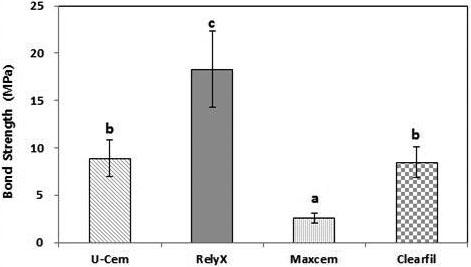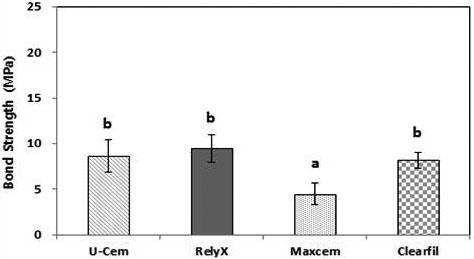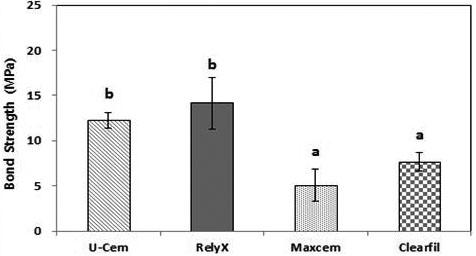
피착재와 자가접착 레진시멘트의 종류에 따른 우치 상아질과의 전단결합강도
Abstract
The purpose of this study was to evaluate the shear bond strengths of self-adhesive resin cements that was applied similar to clinical condition between bovine dentin and four types of adherend. The self-adhesive resin cements, which were used in this study, included U-Cem Premium (U-Cem, Vericom), Rely X Unicem II Automix (Rely X, 3M ESPE), Maxcem Elite (Maxcem: Kerr) and Clearfil SA luting Cement (Clearfil, Kuraray). Four types of adherends, which were used in the research, included composite resin block for CAD-CAM (Polyglass Blank, Vericom), base metal (Vera Bond 2V, Albadent), zirconia (Mazic zir, Vericom) and lithium disilicate (IPS E.max, Ivoclar/Vivadent). The block of adherend was made with breadth 3 mm × length 3 mm × height 3 mm. It adhered adherend to bovine dentin, repeated photopolymerization twice by 20 seconds per surface in the status of applying the load in 5 N, added 30 minutes to the holding time following the polymerization instructed by a maker, and then kept it in 37°C dry oven. The adhered specimen was kept for 24 hours in 37°C distilled water until before the experiment. The shear bond strength was measured with 0.75 mm/min cross-head speed by using a universal testing machine(Z020, Zwick, Ulm, Germany). The blade of the used jig was a straight line. The bond strength with resin adherend was the highest in Rely X. U-cem and Clearfil were significantly higher than Maxem.(p<0.05). As for the bond strength with zirconia, Rely X and U-Cem were significantly higher than other self-adhesive resin cements(p<0.05). In terms of the bond strength with metal and lithium disilicate, Rely X, U-Cem, Clearfil were significantly higher than Maxcem(p<0.05). Hence, Rely X is recommended to the adhesion with the composite resin adherend. Rely X and U-Cem are recommended to the adhesion of zirconia. Maxem, which shows the lowest bond strength in all adherends, needs to be paid a great attention given being used in a clinical trial.
Keywords:
Self-adhesive resin cement, Shear bond strength, Adherend, Bovine teethⅠ. INTRODUCTION
보철물과 치아가 접착제에 의해 성공적으로 합착하게 되면 보철물의 유지와 변연 적합성을 향상시키게 된다(Aktemur 등, 2013). 최근에는 심미적이면서 기계적 성질이 우수한 레진 제재 시멘트가 세라믹 및 지르코니아 또는 복합레진과 비귀금속의 간접 수복물 합착을 위해 널리 사용되고 있다.
레진시멘트가 보철물과 치아와의 성공적인 합착을 위해서는 몇가지 전처리 과정이 필요하다. 이러한 전처리 과정은 기술적으로 민감해서 취급하면서 실수를 범하기 쉽다. 이러한 예로 레진 제재 시멘트는 환자의 구강안의 타액이나 혈액에 의해 오염이 되면 결합강도가 감소한다는 연구도 보고되고 있다(Monticelli 등, 2008; Frankenberger 등, 2009). 따라서 최근에 self-etching primer를 함유하고 있어 치아에 산부식 또는 primer 및 본딩제를 도포하는 전처리 과정이 생략된 자가접착 레진시멘트가 개발되어 적용되고 있다(Trevor, 2005). 자가접착 레진시멘트의 성분은 인산그룹과 염기성 충진재로 구성되어 있다(Ferracane 등, 2011). 그리고 다기능의 phosphoric acid methacrylates를 포함하고 있어 접착 초기에 낮은 pH환경과 친수성의 성질을 제공한다. 이어 단량체의 음전하를 띄는 그룹이 치아의 칼슘이온과 결합하고 필러의 알칼리성 부분과 함께 중화반응을 일으킨다(Behr 등, 2004; Cobb 등, 2004).
자가접착 레진시멘트는 지르코니아 제재의 crown과 bridge에 많이 사용되며, all ceramic crown, bridge, inaly, onlay의 접착에 적용된다. 금속 또는 PFM crown bridge도 적응 증이며, 금속 또는 fiber 포스트의 접착에도 추천된다(Attia, 2011; Brunzel 등, 2010). 위와 같은 피착재에는 별도의 표면처리가 이루어 져야 한다. 지르코니아의 경우에는 선택적 침투 부식법(Selective infiltration etching technique), 레이져 부식(laser etching), alumina coating, silica ceramic coating, 공기-입자 연마를 통해 결합강도를 증가 시킬 수 있다(Aboushelib 등, 2007; Cavalcanti 등, 2009; Kitayama 등, 2009; Kitayama 등, 2010). 세라믹에는 5% 불산을 사용하여 산부식 또는 primer를 도포하는 전처리 과정이 필요하며, 간접 레진 수복물에도 primer를 도포하는 등 제조사에 따라 피착재별로 전처리 과정이 다양하므로 제조사의 지시에 따라야 한다.
기존의 연구들은 대부분 레진 제재 시멘트와 우치 또는 레진시멘트와 피착재 사이의 전단결합강도에 관한 것들이다. 하지만 대부분 우치 또는 피착재 위에 실린더 형태의 몰드를 올린 다음 레진시멘트를 채우고 중합하여 접착하는 연구가 주를 이루고 있다(Mak 등, 2002; Stewart 등, 2002; Ferracane 등, 2011). 이러한 방법은 실제 임상에서 레진시멘트가 적용되는 양상과 다르며, 현재까지 여러 가지 피착재별로 레진시멘트의 종류에 따라 전단결합강도를 비교 분석한 연구가 없는 실정이다.
본 연구의 목적은 임상에서 자가접착 레진시멘트가 실제 적용되는 방식대로 네가지 종류의 피착재와 우치 사이에 레진시멘트를 얇게 적용하여 전단결합강도를 평가하는 것이다. 또한 각 피착재별로 가장 우수한 자가접착 레진시멘트를 찾고, 자가접착 레진시멘트별로 잘 합착되는 피착재를 찾아 임상에서 가이드라인(guideline)으로 삼고자 한다.
Ⅱ. MATERIALS AND METHODS
1. 실험 재료
본 연구에는 4가지 자가접착 레진시멘트가 실험에 사용되었으며 모두 dual-cure type 이였다(Table 1). 전단결합강도 실험에서 각 시멘트마다 피착재 별로 5개의 시편을 제작하였다.
실험에 사용된 우치는 발거 후 3일 이내의 전치부만 사용하였다. 우치는 증류수에 넣어 4℃에서 냉장 보관하여 사용하였다.
2. 전단결합강도
우치에 접착할 피착재를 제작하기 위하여 복합레진(polyglass Blank, Vericom), 금속(Vera Bond2V, Albadent), 지르코니아(Mazic zir, Vericom), lithium disilicate(IPS E.max, voclar/Vivadent) 등 4가지가 사용되었다(Table 2). 피착재 블록은 가로 3 mm × 세로 3 mm × 높이 3 mm의 정육면체였다.
발거 후 7일 이내의 우식이 없는 80개 우치를 백악법랑경계에서 치근부분은 절단하고 치관부분을 사용하였으며 치수를 제거하고 utility wax로 매립하였다. 그 다음 피착재를 접착할 부위를 아래로 향하게 하고 고정한 후, 원통형 테플론 몰드에 교정용 아크릴릭 레진(Ortho-Jet, Lang Dental Manufacturing co., Wheeling, USA)을 사용하여 포매하였다. 그 다음 연마지 120번, 400번을 사용하여 superficial dentin이 노출될 때까지 연마한 후 밀폐된 용기안의 37℃ 증류수에 보관하였다.
포매한 80개의 우치시편은 자가접착 레진시멘트의 종류와 피착재에 따라 실험군을 5개씩 분류하였다. 접착 전에 치면을 10초간 수세 후 우치의 superficial dentin의 접착부위는 평평한 형태의 물이 젖어 있는 상태로 유지하고, 나머지 부위는 여과지를 사용하여 닦아내었다. 복합레진 피착재는 연마지 200, 600번을 사용하여 연마한 후, V-Sil Silane Primer (VERICOM, Chuncheon, Korea)를 5초간 적용 후 건조하였다. 금속과 지르코니아 피착재는 연마지 200, 600번을 사용하여 연마한 후, 50㎛ alumina로 35 psi 압력으로 20초간 sandblasting하였다. lithium disilicate 피착재는 연마지 200, 600번을 사용하여 연마한 후, 불산(HF)으로 처리하고 V-Sil Silane Primer를 5초간 적용 후 건조하였다. 피착재에 대한 처리는 Table 3과 같다. 위와 같이 표면처리가 된 피착재에 4가지 자가접착 레진시멘트를 각각 도포하여 치면에 접착한 후 5 N의 하중을 가한 후 과잉의 레진시멘트를 제거한 후 oxygen shielding 재료를 1 mm 의 직경과 두께로 복합레진 피착재 변연부에 도포하였다.
5 N의 하중을 가한 상태로 면 당 20초씩 광중합을 2회 반복한 후 제조사가 지시한 중합 후 유지시간에 30분을 더하여 37℃ dry oven안에서 유지하였다. 접착된 시편은 시험 전까지 37℃ 증류수에 24시간 동안 보관하였다. 전단결합강도는 만능시험기(Z020, Zwick, Ulm, Germany)를 이용하여 0.75 mm/min cross-head speed로 측정하였으며(ISO/TS 16506, 2015) 사용된 지그는 Figure 1과 같다.
3. 통계분석
통계분석은 SPSS 프로그램(SPSS 12.0; SPSS GmbH, Munich, Germany)을 이용하였다. 모든 실험군의 전단결합강도를 one-way ANOVA로 신뢰수준 95%에서 분석하였고, 사후검정으로 Duncan’s multiple range test를 시행하였고, 전단결합강도에 대한 자가접착 레진시멘트와 피착재의 두 변수의 상호작용효과를 신뢰수준 95%에서 two-way ANOVA로 분석하였다.
Ⅲ. RESULTS
1. 피착재 별 자가접착 레진시멘트의 전단결합강도
피착재 별로 자가접착 레진시멘트의 전단결합강도는 Figure 2∼5와 Table 4와 같다. 복합레진 피착재와의 결합강도는 Rely X > U-Cem, Clearfil > Maxcem 의 순서였다 (p<0.05)(Figure 2). 금속 피착재와 lithium disilicate 피착재의 결합강도는 Rely X, U-Cem, Clearfil > Maxcem 의 순서였다 (p<0.05)(Figure 3, Figure 4). 지르코니아 피착재와의 결합강도는 Rely X, U-Cem > Clearfil, Maxcem 의 순서였다 (p<0.05)(Figure 5).
파절양상은 모든 시편에서 레진시멘트와 치아 사이에서 일어난 접착파절이었다. 레진 시멘트는 모두 피착재측에 부착되어 있었다.

Shear bond strengths of self-adhesive resin cements against composite resin adherends. Different lowercase letters mean the statistical difference (One-way ANOVA and Duncan's multiple range test at α=0.05).

Shear bond strengths of self-adhesive resin cements against metal adherends. Different lowercase letters mean the statistical difference (One-way ANOVA and Duncan's multiple range test at α=0.05).

Shear bond strengths of self-adhesive resin cements against lithium disilicate adherends. Different lowercase letters mean the statistical difference (One-way ANOVA and Duncan's multiple range test at α=0.05).
2. 자가접착 레진시멘트별 피착재의 전단결합강도
자가접착 레진시멘트별로 피착재의 전단결합강도는 Table 4와 같다. U-Cem은 지르코니아 피착재의 결합강도가 가장 높았고(p<0.05), 복합레진, 금속, lithium disilicate 피착재와는 유의차가 없었다(p>0.05). RelyX는 복합레진 피착재와의 결합강도가 가장 높았으나(p<0.05), 지르코니아 피착재와는 유의차가 없었다(p>0.05). Lithium dislicate 피착재와 금속 피착재와의 결합강도가 가장 낮았으나(p<0.05), Lithium dislicate 피착재는 지르코니아 피착재와 유의차가 없었다(p>0.05). Maxcem은 지르코니아와의 결합강도가 가장 높았으나(p<0.05), lithium disilicate와는 유의차가 없었다(p>0.05). 복합레진과 금속 피착재와의 결합강도가 가장 낮았으나(p<0.05), 복합레진 피착재는 lithium disilicate 피착재와 유의차가 없었다(p>0.05). Clearfil은 피착재간에 유의성있는 차이가 없었다(p>0.05).
전단결합강도에 대한 자가접착 레진시멘트와 피착재의 두 변수의 상호작용효과를 이원분산분석한 결과는 Table 5와 같다. 자가접착 레진시멘트와 피착재 사이의 상호작용효과는 F=9.041, p=0.000로서 유의적이므로 상호작용이 존재하며, 전단결합강도는 피착재와 레진시멘트에 따라 다르다고 할 수 있다.

Shear bond strengths (Mean±SD) of self-adhesive resin cements on composite resin, base metal, zirconia, and lithium disilicate adherends. Unit: MPa
Ⅳ. DISCUSSION
본 연구에서는 임상에서 자가접착 레진시멘트가 실제 적용되는 방식대로 네가지 종류의 피착재와 우치 사이에 레진시멘트를 얇게 적용하여 전단결합강도를 평가하고 각 피착재별로 가장 우수한 자가접착 레진시멘트를 찾고, 자가접착 레진시멘트별로 잘 합착되는 피착재를 찾아보고자 하였다.
Rely X는 모든 피착재에서 다른 자가접착 레진시멘트에 비해 높은 결합강도를 보였다. Rely X는 글래스 아이오노머에 새로운 메타크릴산염 인산에스테르가 더해졌는데 메타크릴산염 인산에스테르 모노머는 두 개 또는 그이상의 PO43+와 두 개의 탄소 이중결합으로 이루어져 있다. 인산염과 치아표면의 칼슘이온은 안정적인 화학적 결합을 하여 치아와의 결합력을 증가시킨다. 또한 불포화 이중 결합은 매우 강한 교차결합을 일으키며, 중합 후에 교차결합한 구조가 Rely X의 우수한 기계적 물성에 의해 유지된다는 보고가 있다(Liu 등 2014). 위와 같은 이유로 Rely X가 다른 자가접착 레진시멘트에 비해 높은 결합강도를 보인 것으로 사료된다.
Rely X 다음으로 U-Cem이 모든 피착재에서 높은 결합강도를 보였다. 그 원인으로 4-META를 접착성 레진에 넣어 사용하게 되면 상아질에 대한 접착력을 높인다고 보고되고 있으며, 4-META와 같은 접착을 촉진하는 단량체가 포함된 접착성 레진은 탈회된 치면의 내부로 확산, 침투하여 상아질과 레진의 hybrid layer를 형성함으로써 상아질에 대한 접착강도가 높아진다는 연구결과가 있다(Nakabayashi 등, 1992). 위의 이유로 U-Cem의 구성성분인 4-META와 접착성 레진이 만나 높은 전단결합강도를 보인 것이라 사료된다.
U-Cem은 지르코니아 피착재의 결합강도가 가장 높았고(p<0.05), 복합레진, 금속, lithium disilicate 피착재와는 유의차가 없었다(p>0.05). U-Cem이 지르코니아 피착재와 결합강도가 높은 이유는 U-Cem 안의 4-META 성분이 레진시멘트와 지르코니아의 접착을 위해 중요한 역할을 하며, 지르코니아와의 결합강도를 높인다는 연구보고가 있다. 또한 지르코니아와 화학적으로 결합한다는 연구보고도 있다. 따라서 본 연구에서도 4-META 성분이 들어 있는 U-CEM이 지르코니아와 높은 결합강도를 보인 것으로 사료된다. 임상에서 레진시멘트로 지르코니아를 합착할 때, 큰 무리 없이 허용되는 결합강도는 최소 10∼13 MPa 이다(Luthy 등, 2006).
Luthy 등(2006)의 연구에서는 지르코니아 위에 지름과 높이가 3 mm의 원통형 몰드에 레진시멘트를 채워 0.8 mm/min cross-head speed로 전단결합강도를 측정하여 본 연구의 시험조건과 달라 절대적인 비교가 어렵지만, 본 연구에서는 지르코니아 피착재와의 결합강도가 U-Cem은 12.2 MPa, Rely X는 14.1 MPa로 10 MPa보다 높아 비교적 임상에서 큰 무리 없이 사용이 가능할거라 사료된다. 지르코니아 표면을 공기-입자 연마 처리할 경우 표면이 미세하게 거칠어져 접착부위의 표면 에너지와 젖음성이 증가된다는 연구보고도 있다(Oyague 등, 2009; Oyague 등, 2009). 본 연구에서는 50 µm aluminum oxide를 사용하여 35 psi의 압력으로 20초 동안 sandblasting 하였다. Attia(2011)의 연구에서는 0.28 MPa, 약 40 psi의 압력으로 13초 동안 sandblasting 하였다. 이럴 경우 Rely X의 한 달 동안 열순환 했을 때의 미세인장강도는 6.2 MPa이 나왔다. 하지만 50 µm Al2O3 입자로 약 40 psi의 압력으로 13초 동안 sandblasting하고 30 µm SiO2로 sandblasting 36 psi의 압력으로 20초 동안 실리카 코팅을 했을 때에는 8.4 Mpa, 실리카 코팅을 하고 실란처리를 했을 때에는 10.5 MPa이 나왔다. 본 연구에서는 열순환을 하지 않았으며, 전단결합강도를 측정한 수치이기 때문에 Attia(2011)의 연구와 절대적인 비교는 어렵지만, 실리카 코팅을 하고 실란처리를 했을 때 열순환을 한달 동안 시행한 후 최소 기준치인 10 MPa을 넘었기 때문에 지르코니아의 피착재의 표면 처리방법 또한 결합강도에 많은 영향을 끼침을 알 수 있다.
Rely X는 복합레진 피착재와의 결합강도가 가장 높았으나(p<0.05), 지르코니아 피착재와는 유의차를 보이지 않았다(p>0.05). 따라서 Rely X는 Lithium dislicate 피착재와 금속 피착재보다 복합레진 피착재와 지르코니아와 더욱 합착이 잘된다는 것을 알 수 있었다. Rely X가 복합레진 피착재와의 결합강도가 가장 높게 나타난 것에 대한 이유에 대해서 Rely X의 어느 성분이 어떤 반응으로 레진과의 결합력을 증진시키는지에 대해서는 추후 연구해 볼 필요가 있다.
하지만 Maxcem은 모든 피착재에서 다른 자가접착 레진시멘트에 비해 낮은 전단결합강도를 보여 임상에서 사용 시 신중하게 고려할 필요가 있다고 생각된다.
본 연구의 한계점은 사람의 치아가 아닌 우치의 상아질을 사용한 점이다. 하지만 사람치아와 우치의 전단결합강도가 유의성 있는 차이를 보이지 않았다는 보고가 있다(Rüttermann 등, 2013). 이에 따라 본 연구의 결과는 비교적 신뢰할 수 있을 거라 사료된다.
본 연구를 통해서 복합레진의 접착에는 Rely X가 추천되며, 금속 피착재와 lithium disilicate의 접착에는 Rely X, U-Cem, Clearfil이 추천되고, 지르코니아의 접착에는 Rely X과 U-Cem이 임상적으로 유용하게 사용 될 것으로 사료된다.
Ⅴ. CONCLUSION
본 연구에서는 임상에서 자가접착 레진시멘트가 실제 적용되는 방식대로 네가지 종류의 피착재와 우치 사이에 레진시멘트를 얇게 적용하여 전단결합강도를 평가한 결과 다음과 같은 결과를 얻었다.
- 1. 비귀금속 피착재와 lithium disilicate 피착재의 경우 전단결합강도의 순서는 Rely X, U-Cem, Clearfil > Maxcem 순이었고(p<0.05), 지르코니아 피착재의 경우 Rely X, U-Cem > Clearfil, Maxcem 순이었고(p<0.05), 복합레진 피착재의 경우 Rely X > U-Cem, Clearfil > Maxcem 순이었다(p<0.05).
- 2. 자가접착 레진시멘트 내에서 살펴보면, RelyX는 복합레진 피착재 ≧ 지르코니아 피착재 ≧ Lithium dislicate 피착재 ≧ 금속 피착재 순이었고, U-Cem 은 지르코니아 피착재 > 복합레진, 금속, lithium disilicate 피착재 순이었고(p<0.05), Clearfil은 피착재간에 결합강도의 차이가 없었다(p>0.05).
- 3. Maxcem의 결합강도는 모든 피착재에서 다른 자가접착 레진시멘트보다 낮았다(p<0.05).
이상의 결과로 복합레진 피착재와의 접착에는 Rely X가 추천되며, 금속 피착재와 lithium disilicate 피착재의 접착에는 Rely X, U-Cem, Clearfil이 추천되고, 지르코니아의 접착에는 Rely X과 U-Cem이 임상적으로 유용하게 사용 될 것으로 추천된다.
Acknowledgments
이 논문은 2014년도 원광대학교의 교비지원에 의해서 수행됨.
Ⅵ. REFERENCES
-
Aboushelib, MN., Kleverlaan, CJ., Feilzer, AJ., (2007), Selective infiltration-etching technique for a strong and durable bond of resin cements to zirconia-based materials, J Prosthet Dent, 98, p379-388.
[https://doi.org/10.1016/S0022-3913(07)60123-1]

-
Aktemur Türker, S., Uzunoğlu, E., Yılmaz, Z., (2013), Effects of dentin moisture on the push-out bond strength of a fiber post luted with different self-adhesive resin cements, Restor Dent Endod, 38, p234-240.
[https://doi.org/10.5395/rde.2013.38.4.234]

-
Attia, A., (2011), Bond strength of three luting agents to zirconia ceramic - influence of surface treatment and thermocycling, J Appl Oral Sci, 19, p388-395.
[https://doi.org/10.1590/S1678-77572011005000015]

-
Behr, M., Rosentritt, M., Regnet, T., Lang, R., Handle, G., (2004), Marginal adaptation in dentin of a self-adhesive universal resin cement compared with well-tried systems, Dent Mater J, 20, p191-197.
[https://doi.org/10.1016/S0109-5641(03)00091-5]

-
Cavalcanti, AN., Foxton, RM., Watson, TF., Oliveira, MT., Giannini, M., Marchi, GM., (2009), Bond strength of resin cements to a zirconia ceramic with different surface treatments, Oper Dent, 34, p280-287.
[https://doi.org/10.2341/08-80]

-
Chen, C., Kleverlaan, CJ., Feilzer, AJ., (2012), Effect of an experimental zirconia-silica coating technique on micro tensile bond strength of zirconia in different priming conditions, Dent Mater, 28, p127-134.
[https://doi.org/10.1016/j.dental.2012.04.020]

-
Chen, L., Shen, H., Suh, BI., (2013), Effect of incorporating BisGMA resin on the bonding properties of silane and zirconia primers, J Prosthet Dent, 110, p402-407.
[https://doi.org/10.1016/j.prosdent.2013.04.005]

- Cobb, D. Timmons, Stanford, C., Dawson, D., Denehy, G., Vargas, M., (2004), Clinical outcomes of ceramic inlays/ onlays luted with two bonding systems, J Dent Res, 83, p1539.
-
da Silva, EM., Miragaya, L., Sabrosa, CE., Maia, LC., (2014), Stability of the bond between two resin cements and an yttria-stabilized zirconia ceramic after six months of aging in water, J Prosthet Dent, 112, p568-575.
[https://doi.org/10.1016/j.prosdent.2013.12.003]

-
de Souza, G., Hennig, D., Aggarwal, A., Tam, LE., (2014), The use of MDP-based materials for bonding to zirconia, J Prosthet Dent, 112, p895-902.
[https://doi.org/10.1016/j.prosdent.2014.01.016]

-
Ferracane, JL., Stansbury, JW., Burke, FJ., (2011), Self-adhesive resin cements - chemistry, properties and clinical considerations, J Oral Rehabil, 38, p295-314.
[https://doi.org/10.1111/j.1365-2842.2010.02148.x]

-
Frankenberger, R., Reinelt, C., Petschelt, A., Kramer, N., (2009), Operator vs. material influence on clinical outcome of bonded ceramic inlays, Dent Mater, 25, p960-968.
[https://doi.org/10.1016/j.dental.2009.02.002]

- International Organization for standardization, ISO/TS 16506, Dentistry-Polymer-based luting materials containing adhesive components, Geneva: ISO, (2015).
-
Kitayama, S., Nikaido, T., Maruoka, R., Zhu, L., Ikeda, M., Watanabe, A., Foxton, RM., Miura, H., Tagami, J., (2009), Effect of an internal coating technique on tensile bondstrengths of resin cements to zirconia ceramics, Dent Mater J, 28, p446-453.
[https://doi.org/10.4012/dmj.28.446]

-
Kitayama, S., Nikaido, T., Takahashi, R., Zhu, L., Ikeda, M., Foxton, RM., Sadr, A., Tagami, J., (2010), Effect of primer treatment on bonding of resin cements to zirconia ceramic, Dent Mater, 26, p426-432.
[https://doi.org/10.1016/j.dental.2009.11.159]

-
Liu, C., Liu, H., Qian, YT., Zhu, S., Zhao, SQ., (2014), The influence of four dual-cure resin cements and surface treatment selection to bond strength of fiber post, Int J Oral Sci, 6, p56-60.
[https://doi.org/10.1038/ijos.2013.83]

-
Luthy, H., Loeffel, O., Hammerle, CH., (2006), Effect of thermocycling on bond strength of luting cements to zirconia ceramic, Dent Mater, 22, p195-200.
[https://doi.org/10.1016/j.dental.2005.04.016]

-
Mak, YF., Lai, SC., Cheung, GS., Chan, AW., Tay, FR., Pashley, DH., (2002), Microtensile bond testing of resin cements to dentin and an indirect resin composite, Dent Mater, 18, p609-621.
[https://doi.org/10.1016/S0109-5641(02)00005-2]

-
Monticelli, F., Osorio, R., Mazzitelli, C., Ferrari, M., Toledano, M., (2008), Limited decalcification/diffusion of self-adhesive cements into dentin, J Dent Res, 87, p974-979.
[https://doi.org/10.1177/154405910808701012]

- Nakabayashi, N., Ashizawa, M., Nakamura, M., (1992), Identification of a resin-dentin hybrid layer in vital human dentin created in vivo: durable bonding to vital dentin, Quintessence Int, 23, p135-41.
-
Oyague, RC., Monticelli, F., Toledano, M., Osorio, E., Ferrari, M., Osorio, R., (2009), bonding to densely-sintered zirconiumoxide ceramic, Dent Mater, 25, p172-179.
[https://doi.org/10.1016/j.dental.2008.05.012]

-
Oyague, RC., Monticelli, F., Toledano, M., Osorio, E., Ferrari, M., Osorio, R., (2009), Effect of water aging on microtensile bond strength of dual-cured resin cements to pre-treated sintered zirconium-oxide ceramics, Dent Mater, 25, p392-399.
[https://doi.org/10.1016/j.dental.2008.09.002]

-
Rüttermann, S., Braun, A., Janda, R., (2013), Shear bond strength and fracture analysis of human vs. bovine teeth, PLoS One, 8, pe59181.
[https://doi.org/10.1371/journal.pone.0059181]

-
Stewart, GP., Jain, P., Hodges, J., (2002), Shear bond strength of resin cements to both ceramic and dentin, J Prosthet Dent, 88, p277-84.
[https://doi.org/10.1067/mpr.2002.128034]

- Trevor, FJ., (2005), Trends in Indirect Dentistry: 3. Luting Materials, Dental Update, 32, p251-260.

